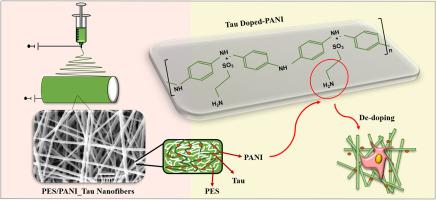当前位置:
X-MOL 学术
›
Synth. Met.
›
论文详情
Our official English website, www.x-mol.net, welcomes your feedback! (Note: you will need to create a separate account there.)
Enhancing biocompatibility of polyaniline-based scaffolds by using a bioactive dopant
Synthetic Metals ( IF 4.4 ) Pub Date : 2021-01-01 , DOI: 10.1016/j.synthmet.2020.116642 Zohreh Daraeinejad , Iman Shabani
Synthetic Metals ( IF 4.4 ) Pub Date : 2021-01-01 , DOI: 10.1016/j.synthmet.2020.116642 Zohreh Daraeinejad , Iman Shabani

|
Abstract The role of dopant in the cytotoxicity of polyaniline (PANI) nanofibers was investigated invitro. The testing was carried out on extracts of nanofibers to show the release of dopants in the cell culture medium and their positive or negative effects at different concentrations. In this work, camphor sulfonic acid (CSA) has been replaced by taurine (Tau) in PANI/poly(ethersulfone) (PES) nanofibrous scaffolds that possesses both electrical conductivity and bioactivity. The conductive scaffolds were fabricated via electrospinning and the effect of Tau and CSA on morphology, conductivity, and biocompatibility of scaffolds were studied. The extraction of the CSA-doped PANI nanofibers showed moderate cytotoxicity, while the viability of cells fed with the extraction of Tau-doped PANI nanofibers was higher than other samples. We proposed that PANI-Tau-based nanofibers can be used as a bioactive conductive scaffold for tissue engineering applications. This approach can be an important step towards improving the biocompatibility of conductive PANI-based biomaterials.
中文翻译:

通过使用生物活性掺杂剂提高聚苯胺基支架的生物相容性
摘要 体外研究了掺杂剂在聚苯胺 (PANI) 纳米纤维的细胞毒性中的作用。测试是对纳米纤维的提取物进行的,以显示细胞培养基中掺杂剂的释放及其在不同浓度下的正面或负面影响。在这项工作中,樟脑磺酸 (CSA) 在 PANI/聚醚砜 (PES) 纳米纤维支架中被牛磺酸 (Tau) 取代,具有导电性和生物活性。通过静电纺丝制备导电支架,并研究了 Tau 和 CSA 对支架的形态、电导率和生物相容性的影响。CSA 掺杂的 PANI 纳米纤维的提取显示出中等的细胞毒性,而用 Tau 掺杂的 PANI 纳米纤维的提取物喂养的细胞的活力高于其他样品。我们提出基于 PANI-Tau 的纳米纤维可用作组织工程应用的生物活性导电支架。这种方法可能是提高基于导电 PANI 的生物材料的生物相容性的重要一步。
更新日期:2021-01-01
中文翻译:

通过使用生物活性掺杂剂提高聚苯胺基支架的生物相容性
摘要 体外研究了掺杂剂在聚苯胺 (PANI) 纳米纤维的细胞毒性中的作用。测试是对纳米纤维的提取物进行的,以显示细胞培养基中掺杂剂的释放及其在不同浓度下的正面或负面影响。在这项工作中,樟脑磺酸 (CSA) 在 PANI/聚醚砜 (PES) 纳米纤维支架中被牛磺酸 (Tau) 取代,具有导电性和生物活性。通过静电纺丝制备导电支架,并研究了 Tau 和 CSA 对支架的形态、电导率和生物相容性的影响。CSA 掺杂的 PANI 纳米纤维的提取显示出中等的细胞毒性,而用 Tau 掺杂的 PANI 纳米纤维的提取物喂养的细胞的活力高于其他样品。我们提出基于 PANI-Tau 的纳米纤维可用作组织工程应用的生物活性导电支架。这种方法可能是提高基于导电 PANI 的生物材料的生物相容性的重要一步。



























 京公网安备 11010802027423号
京公网安备 11010802027423号